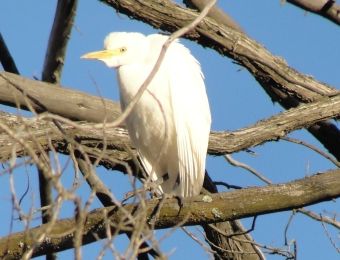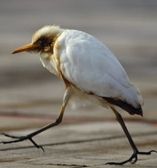
Publisher:
Bonnie King
CONTACT:
Newsroom@Salem-news.com
Advertising:
Adsales@Salem-news.com

~Truth~
~Justice~
~Peace~
TJP
Jun-17-2010 23:13

 TweetFollow @OregonNews
TweetFollow @OregonNews
By Many Names, Still the Same Egret
Gail Parker Salem-News.comArdea ibis Linnaeus, 1758, Ardeola ibis, Bubulcus bubulcus, Buphus coromandus, Cancroma coromanda, Egretta ibis (Linnaeus, 1758) & Lepterodatis ibis (Linnaeus, 1758)
 Above: "Symbiosis" Cattle and cattle egrets are vectors of Psilocybe cubensis spores. |
(PATAGONIA, Argentina) - The Ardeola ibis is actually a type of heron, but unlike most herons, it can be found away from water.
Commonly called the cattle egret, it is familiar from wildlife documentaries hitching a ride, and a lunch, on the back of a rhinoceros. Since a mere 150 years ago, it has expanded widely from its original range, and is now familiar to most of us.
Known in Spanish as the Garcita Buyera, it flies such immense distances that it has even been seen mid-Atlantic.
Originally from Africa and Europe, these lovely white birds first colonized in Guiana and Surinam in the late 19th century, and rapidly spread north to southern Canada by 1962 and also south, reaching Argentina in the 1970’s. Today their range is nearly worldwide, due to their switch from association with wild beasts to a symbiosis with domesticated animals such as horses and cattle.

This relationship is what has allowed them to fill an otherwise empty niche. The cattle egret has managed this breathtaking expansion from their origins in Asia, Africa and Europe because they have a high reproductive rate, a long breeding season, few predators, and because there has been a huge increase in worldwide agriculture and livestock production.
Tito Narosky, the ornithologist who was among those who first sighted the bird in Argentina, says that "it is one of the best documented avian range expansions in this century”. This might qualify them as an invasive species, although there have been no negative impacts noted yet.
In fact, they were introduced into Hawaii as a bio-control for flies and maggots, grasshoppers, ticks and other infestations on cattle ranges. They also sometimes eat amphibians, fish and reptiles.
During the past six weeks, a pair of Garcita bueyera have been seen in our barrio where by long practice, horses are free to roam. Though these two are alone, the cattle egret is often seen in flocks during migrations, especially in autumn.
The Cattle Egret is a stocky heron with a 35–38" wingspan. It has a sturdy bill and a relatively short, thick and retractable neck, resulting in a hunched posture. I was puzzled by the fact that my visitors seem to be about 12 to 14 inches in height, yet my Illustrated Manual of the Birds of Patagonia describes their height as 500 mm or closer to 20". Senor Ors Kovacs, one of the authors of my manual, patiently explained to me that the measure of a bird is taken from the tip of the feet to the end of the bill. I had been fooled into thinking they were far shorter than they really were.
Though the breeding adult in other areas has a yellowish or orange-buff coloration on the back, breast and crown, in our area it does not, and remains white throughout the year. The bill and eye are yellow and the legs are grayish-yellow. The sexes are similarly colored, though the male is very slightly larger. Usually a quiet bird, they do have a throaty, soft call during mating season.
They nest in great colonies with other herons, and lay up to five pale celeste eggs. Juvenile birds have a black bill and darker legs. Unfortunately, the cattle egret's breeding grounds include the area around the Gulf of Mexico.
Sources:
- Manual ilustrado de las Aves de la Patagonia by Carlos Julio Kovacs, Ors Kovacs, Zsolt Kovacs and Carlos Mariano Kovacs
- Birds of Southern and South America and Antarctica by Martin R. De La Pena and Maurice Rumboll
- Birds of Argentina and Uruguay by Tito Narosky and Dario Yzurieta
=============================================
 Gail Parker is a writer and photographer who lives in Argentina. She and her lifetime mate and husband Eddie Zawaski, who also writes for Salem-News.com, are former residents of Oregon, Gail has a great eye for memorable photos in this unique place called Patagonia. Her observations from this amazing wonderland of nature are a fun and welcome addition to our story flow.
Gail Parker is a writer and photographer who lives in Argentina. She and her lifetime mate and husband Eddie Zawaski, who also writes for Salem-News.com, are former residents of Oregon, Gail has a great eye for memorable photos in this unique place called Patagonia. Her observations from this amazing wonderland of nature are a fun and welcome addition to our story flow.
Watch for Gail's wonderful coverage of the birds of Patagonia in future stories and photojournals here on Salem-News.com.
Articles for June 16, 2010 | Articles for June 17, 2010 | Articles for June 18, 2010
Salem-News.com:





Terms of Service | Privacy Policy
All comments and messages are approved by people and self promotional links or unacceptable comments are denied.
[Return to Top]
©2025 Salem-News.com. All opinions expressed in this article are those of the author and do not necessarily reflect those of Salem-News.com.